Progress report for FNC23-1370
Project Information
As co-owner of Whitewater Gardens Farm, I have been sustainably growing produce for 26 years. In attending and presenting at organic conferences, field days and workshops, along with networking with many local growers, I have continued to learn much about sustainable agriculture over the years. I have been active in organizations including the Minnesota Farmers Market Association (Board member 2018-2022), Land Stewardship Project Soil Health Steering Committee (2018-Present), Sustainable Farming Association (mid-1990s-mid-2010s), and others. I also have research experience gained from collaborative crop studies and trials including: 2015 high tunnel disease survey through University of Minnesota; 2013-2017 potato trials with University of Wisconsin at Madison; 2002-2003 compost tea research through Energy and Sustainable Agriculture program at Minnesota Department of Agriculture; and others.
In 1990 my husband Lonny and I purchased Whitewater Gardens Farm which consisted of 120 acres. We have since sold 40 of those acres. All the cropland at the time was in the conservation reserve program. Before that the cropland had been on a corn and soybean rotation and had been badly eroded with no topsoil left. We have worked hard to improve our seaton silt loam soils to produce healthy vegetable crops .
In 1996 we began growing a wide variety of vegetables for farmers markets, wholesale accounts and Community Supported Agriculture using sustainable growing practices on approximately 15 acres. Several years ago, we decided to drop our CSA and concentrate more on wholesale. Our main crops have been carrots, sweet potatoes, fall brassicas, onions, peppers, tomatoes, and salad greens. Around 2000 we added a hoop house, and in 2010 we built a two-bay gutter connect greenhouse for various crops including tomatoes, cucumbers, peppers, and ginger. Since then, we have added four additional hoop houses. In 2017 we certified organic through the Midwest Organic Services Association . Our farming practices have included cover cropping, rotation, tillage, and cultivation, but we would like to move to more no-till/minimal till practices because of the proven benefits to soil health.
Beyond the day-to-day work of farming, we have hosted on-farm outreach events and field days for local organizations including: 2019 tour with Riverway Learning Center K-12 students; 2017 four tours with Lewiston/Altura K-12 students; 2016 University of Minnesota Extension collaboration with staff from the University of Kenya working on farmer outreach; and other events for diverse groups. We have also hosted dinners on the farm featuring local products and chefs (2008-2013).
Tillage disrupts the soil microbiome and, while it leads to short-term gains, ultimately this reduces soil health, increases compaction, and propagates weeds. By comparison, no-till methods, or practices which limit or eliminate mechanical turnover of soil layers, stimulate the growth of natural microorganisms which help to make soil nutrients more biologically available, increase organic matter content, and can reduce overall labor while yielding successful harvests.
No-till farming methods are increasingly part of the dialogue in conventional crop farming, but the techniques employed at large scales are not practical or accessible for small vegetable growers. Multiple recent references (Mefford 2022, 2019; Mays 2020; O’Hara 2020) offer no-till recommendations, but there is little practical guidance for small-scale, organic vegetable farming. Especially in the Midwest, these farms are highly diversified and require flexibility in approach. On our farm, we see little improvement from year to year by tilling our fields, which have highly variable soil, significant compaction, and weed pressure from foxtail and Canada thistle.
This project aims to build understanding for no-till farming methods for vegetable growers by piloting three recommended approaches, comparing results for soil and crop health and economic viability, and sharing results with other growers.
The primary goal of this study is to test recommended methods of no-till vegetable growing to identify the most sustainable approach in terms of soil health, labor investment, and crop health and yield. Over the 2023-2024 growing seasons, we are comparing three no-till treatments with a control (tilled) approach in a randomized test plot with both observed and measured outcomes. Educational outreach for this project includes on-farm field days in addition to sharing results and lessons learned with other growers and researchers.
As of December 2023, we successfully initiated the test plot, collected soil temperature, plant health, and observational data, received analytical results from pre- and post-growing season soil tests, and shared results in one on-farm field day and related educational outreach, despite extreme drought and pest conditions which limited the growing season to August-October.
References:
- Mefford 2022, Practical No-Till Farming
- Mefford 2019, The Organic No-Till Farming Revolution
- Mays 2020, The No-Till Organic Vegetable Farm
- O’Hara 2020, No-Till Intensive Vegetable Culture
Update 07/24/24
Our project has been delayed due to excessive rain late spring into early summer this year. We were able to plant cover crops on the control beds as well as the deep compost beds early in the spring. We also replanted the Dutch white clover in the living mulch beds since we had no germination last year. Both the cover crops and the clover germinated and did well. We were able to flail mow these beds before the heavy rains began.
Before we could prepare the beds further for planting the rains began dropping large amounts every couple of days for the entire late spring into early summer. Since our soil is very heavy clay the excess moisture kept us from planting and maintaining the project beds. With the excess moisture weeds, especially quack grass has crept into the beds.
The ground has now dried out, but we feel it is too late in the season to plant the crop planned for the 2024 season (sweet peppers) successfully and collect relevant data for the project. Our modified plan is to till the control beds and plant a fall cover crop that will freeze back over the winter. The deep compost mulch and cut and carry beds will be tarped to kill back the weeds and quack grasses that have crept in, and the living mulch beds will be mowed to keep weeds back and encourage the clover.
Next spring we propose to continue the project as was planned for this year to complete the project.
We propose to compare three distinct no-till treatment methods with a traditional (tilling) approach to identify the most sustainable. The results will help us plan for and modify no-till methods on our farm and will provide valuable, practical results to share with other vegetable growers.
After review of the most recent literature, we have selected the following no-till treatment methods to study:
- Treatment A: Occultation of cover crop with weed fabric; residue topped with 6 inches of compost. Plant transplants into compost. Maintenance would include hand weeding and hoeing of annual and perennial weeds. This method is being used by several farms switching to no-till methods.
- Treatment B: Flail mow cover crop with a walk-behind-tractor flail mower. Plant transplants into mowed residue and mulch with 6 inches of chopped hay or straw. Maintenance would include hand weeding only. A version of this method has been promoted by Jan-Hendrik Cropp, a German farmer.
- Treatment C: Flail mow cover crop with walk-behind-tractor flail mower. No-till seed clover into residue to grow a living mulch. Plant transplants into seeded residue. Maintenance would include hand weeding only. This method builds upon a SARE grant study by Dana Jokela of Sogn Valley Farm (FNC19-1171), taking his approach one step further by not tilling the bed and monitoring the biological and nutrient activity in the soil.
- Treatment X: Our control method will be a traditional tilling approach including tilling in the cover crop and transplanting directly into prepared soil. Maintenance would include hand weeding and hoeing.
We will test these three methods in a plot on our farm in southeastern Minnesota over two growing seasons (2023 and 2024). The plot (see attached diagram) will have a total area of 6,250 square feet (about 1/6 acre) arranged in 12 beds.
Each bed will be 2.5 feet wide by 100 feet long, with 2.5-foot pathways between beds. Our planned arrangement allows for randomization of each method, including the control, in each of the three replicates, which will reduce the impact of confounding variables and allow us to correct for natural variation across the plot.
Initial preparation will consist of tilling the entire block and forming beds with a tractor-drawn bed shaper raised to approximately 6 inches. All beds will begin with an initial cover crop of a mix of oats, field peas, and buckwheat. Over the 23-month project duration, we will plant two cycles of spring and fall cover crops in addition to a cash crop (cauliflower in 2023 and peppers in 2024) throughout the plot. The no-till treatments will be applied separately to each row.
To identify the most sustainable no-till approach, we will collect soil samples and make routine observations throughout the plot as described in the “measuring results” section. Observations will be recorded using a monthly log for each of the 12 beds. Data will be entered into spreadsheets for statistical analysis. We will cease data collection by December 31, 2024, to allow time for statistical analysis and reporting.
The objectives of this project include:
- Evaluate which of the three treatment methods provides the largest gains in soil health over the project duration by comparing soil sample data and quantitative observations.
- Establish a practical, sustainable balance between labor investment and ecological benefit of three no-till treatments by comparing return on labor with measured soil and crop health.
- Share study progress, results, and practical implementation techniques with other small vegetable growers through farm field days and publication or conference presentations.
Research
After review of the most recent literature, we selected the following no-till treatment methods to study:
- Treatment A: Occultation of cover crop with weed fabric; residue topped with 6 inches of compost. Plant transplants into compost. Maintenance including hand weeding and hoeing of annual and perennial weeds. This method is being used by several farms switching to no-till methods.
- Treatment B: Flail mow cover crop with a walk-behind-tractor flail mower. Plant transplants into mowed residue and mulch with 6 inches of chopped hay or straw. Maintenance would including hand weeding only. A version of this method has been promoted by Jan-Hendrik Cropp, a German farmer.
- Treatment C: Flail mow cover crop with walk-behind-tractor flail mower. No-till seed clover into residue to grow a living mulch. Plant transplants into seeded residue. Maintenance including hand weeding only. This method builds upon a SARE grant study by Dana Jokela of Sogn Valley Farm (FNC19-1171), taking his approach one step further by not tilling the bed and monitoring the biological and nutrient activity in the soil.
- Treatment X: Our control method will be a traditional tilling approach including tilling in the cover crop and transplanting directly into prepared soil. Maintenance including hand weeding and hoeing.
These three methods are being tested in a plot on our farm in southeastern Minnesota over two growing seasons (2023 and 2024). The plot (Figure 1) has a total area of 6,250 square feet (about 1/6 acre) arranged in 12 beds. Each bed is 2.5 feet wide by 100 feet long, with 2.5-foot-wide pathways between beds. Our arrangement allows for three replicates of each method, including the control, which reduces the impact of confounding variables and allows us to correct for natural variation in the soil within the plot.
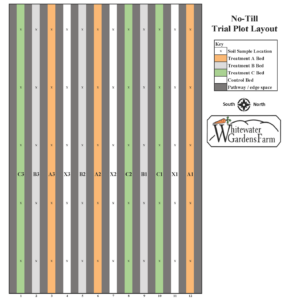
Over the 23-month project duration, we planned to plant two cycles of spring and fall cover crops in addition to a cash crop (cauliflower in 2023 and peppers in 2024) throughout the plot.
The first portion of the study was conducted between June-December 2023. While our study plan called for all beds to begin with an initial cover crop of a mix of oats, field peas, and buckwheat, due to severe drought conditions in 2023, the initial cover crop was not planted, and the test plot remained fallow until June 2023. When the field could be worked in June, initial preparation consisted of tilling the entire block and forming beds with a tractor-drawn bed shaper and raising to approximately 6 inches.
Prior to planting the 2023 cash crop (cauliflower), 6 inches of compost mulch was spread on the “A” rows and 6 inches of cut and carry, dairy grade alfalfa hay mulch was applied to the “B” rows. Due to the drought conditions, the living mulch struggled to germinate after two plantings, so “C” rows were functionally the same as “X” (control) rows in year 1. Fall cauliflower was planted August 2 (Figure 2), a little later than we would usually plant brassicas, but we were hoping weather conditions would prove to be less stressful on the transplants. On a year with no drought, we could have still harvested a crop. However, most of the plots stayed at a standstill though most of the year even though we used drip irrigation once a week overnight with a low flow of one quart per hour. Also, no crops were harvested due to these conditions. The entire test plot was flail-mowed on December 7, 2023.
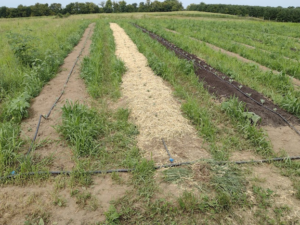
To identify the most sustainable no-till approach, we collected soil samples and made routine measurements and observations throughout the plot. Observations are being recorded in a field notebook and measurement data is being entered into spreadsheets for statistical analysis. We will cease data collection by December 31, 2024, to allow time for statistical analysis and reporting.
In 2023, soil samples were collected in August (prior to planting the cauliflower cash crop) and December (after mowing all remaining plant material). Generic nutrient analysis and a Haney soil test were completed for both August and December soil samples, and a Soil Food Web test was completed for the pre-season sample. Soil temperatures were recorded on a hot day in early October and a cold day in late October. Compaction was measured with a penetrometer in early October (Figure 3). A Brix test was performed in each bed in early October but could not be performed later in the season due to drought conditions. Labor hours and field observations of soil and crop health were recorded throughout the season.
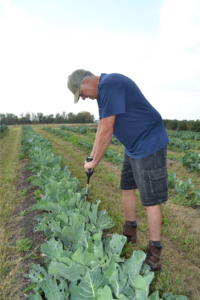
Our year 1 results include observations, soil measurements, and analytical results from June-December 2023.
One of the primary observations that we had was a huge difference in growth between the mulched beds versus control beds and living mulch that did not germinate (Figure 4). The plants in the mulched beds (A and B) were substantially larger than the non-mulched beds (C and X). Though all the beds were very slow to grow due to the weather conditions, the mulched beds were the only beds to start trying to produce cauliflower heads even though they did not grow large enough for harvest.
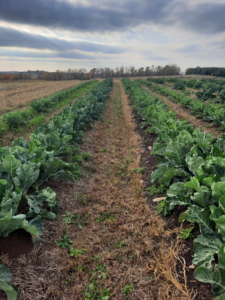
Weed pressure was also different between both the deep compost/cut and carry beds and the control/living mulch beds. The only real weed problem on both mulched beds were Canada thistle while the control/living mulch beds had grasses, chickweed and other weeds as well as the Canada thistle.
Almost all beds had the same insect pest issues, including grasshoppers mid-summer and cabbage moths late summer. We did one application of Bt to mitigate the cabbage moth damage. However, both mulched treatments grew out of the insect damage quicker than the control/living mulch.
All beds sustained heavy gopher damage except for three of the beds on the south end of the field (C3, B3, and A3, see Figure 4). These included one bed each of deep compost mulch, cut and carry mulch, and living mulch. We could not determine why these beds had no gopher damage, but we felt that the gophers took advantage of the lack of soil disturbance that comes with no-till.
Soil temperatures under both mulched beds (Figure 5) tended to be 8 to 10 degrees F cooler under the mulch and down three inches compared to the control/living mulch beds that tested out at air temperature. For brassicas in 2023, that meant very hot soil. The mulched beds also tended to be warmer than the control/living mulch beds when the air temperatures turned cold later in the season.
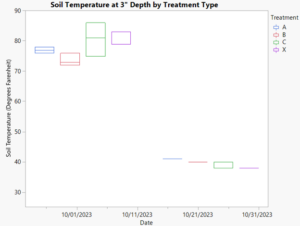
When temperatures dipped below freezing later in the season, the plants in both mulched beds showed more cold damage than the control/living mulch. This could be due to open ground absorbing more heat. But when temperatures warmed up again and the plants thawed, the cut and carry mulch showed the best color and least damage.
Preliminary review of the 2023 soil analytical data revealed the complexity of interpreting soil health from laboratory reports. Soil nutrient values were variable across the plot both within and between treatment types and between the August and December measurements. Box plots of measured values were used to compare the results, and in most cases either no significant change was observed from August to December, or the change appeared uniform between the three treatments and control. Two notable results included diverging potassium levels between the mulched (A and B) beds (Figure 6) and non-mulched (C and X) beds, and an overall increase in carbon and nitrogen levels in all beds (Figure 7). The increase in potassium is likely explained by breakdown of nutrients in the added mulch compared to utilization only in the non-mulched beds. The overall increase in carbon and nitrogen demonstrates the value of maintaining living roots in the soil (late season) compared to the loss caused by drought and tillage (early season).
Because only one Soil Food Web test was completed this year, our review of this data will be conducted after the post-project test in 2024. The August 2023 results indicate good fungal activity across the trial plot (Figure 8).
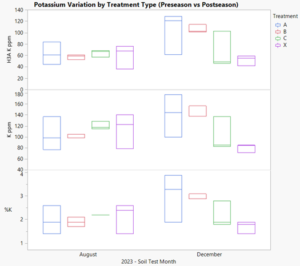
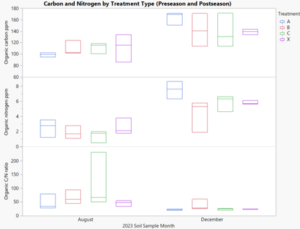
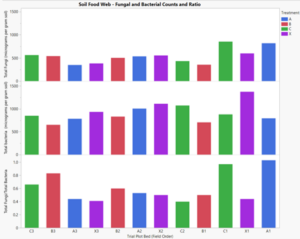
Educational & Outreach Activities
Participation Summary:
We held our first field day October 3, 2023. Notification of the field day was sent via Facebook, our website, Land Stewardship Project and the Climate Resilient Organic Vegetable Production group. There was a mix of farmers and farm advocates who attended (Figure 9). We began the field day talking about the history of the farm and soils when we began farming organic vegetables 28 years ago and the degradation of the soil on the farm from years of conventional farming with no heed to conservation practices. Discussion then proceeded to talk about how we have worked to try to build soil health over the years. Most of our growing methods were the usual high tillage methods used on most organic farms to combat weeds. We discussed how these methods did not achieve the results that we wished and our desire to find a better way toward soil health.
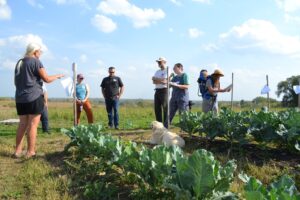
We then toured the no-till beds discussing soil test results using the Haney test as well as Soil Food Web testing to determine microbial activity. Soil test results were attached to posts on the end of each bed for participants to study and discuss (Figure 10). We also compared soil and crop health and the distinct differences between the treatment methods (Figure 11)
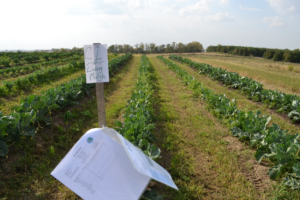
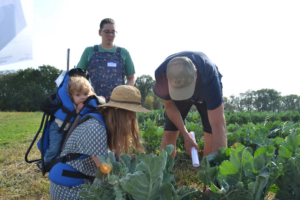
Overall, it was extremely helpful to get perspectives from other farmers, and attendees of the field day and felt that the day was a success. We were encouraged to continue the trial and see what additional results will come in 2024.
One outcome of the field day was being asked to be interviewed for a podcast by Brian DiVore from the Land Stewardship Project who attended the field day, on the grant project, our observations and the importance of soil health. Included is a link to the podcast. http://Ear to the Ground 321: Buried Knowledge
In addition, Volume 41 Number 2, 2023 Land Stewardship Letter included an article on our project and field day, expanding on the history of our area and the need for building back soil health. This newsletter is distributed to all Land Stewardship members and copies are handed out at various conferences.
Other future planned outreach includes:
- January 10, 2024 – Sandy will present to the Climate Resilient Organic Vegetable Production group through University of Wisconsin-Madison
- February 2024 – Sandy will be serving as a panelist in one of the Organic Universities titled “Climate Adaptation for Midwest Organic Vegetable Growers: Current Research and Future Priorities” at the Marbleseed Organic Farming Conference in La Crosse, Wisconsin
- Late Summer 2024 - another field day will be planned to share the results of both years of our findings.
- January 2025 - presentation or poster at the Organic Vegetable Conference
- February 2025 - report will be posted to the research board at the Marbleseed Organic Farming Conference
- Spring 2025 - report and lessons learned will be shared through the Climate Resilience for Organic Vegetable Production web feed.
Update 7/24/24
Sandy participated in the farmer panel in the Organic University "Climate Adaptation for Midwest Organic Vegetable Growers", February 22, 2024 at the Marbleseed Converence in La Crosse, Wisconsin.
September 14, 2024, both Lonny and Sandy will be presenting and sharing first year results at a field day being held near Moorehead, MN at the farm of Noreen and Lee Thomas, Doubting Thomas Farms.
Learning Outcomes
After our first year, we remain convinced this project will contribute to a growing body of knowledge and enthusiasm around no-till farming techniques accessible to small-scale organic vegetable growers.
Of the treatment methods proposed, all have been shown to be effective in decreasing erosion, increasing soil biological activity and organic matter, and increasing water holding capacity. These improvements, in turn, contribute to increased crop production efficiency and quality. Our lessons learned build on previous research (including previous investigations funded by SARE grants, where cited):
- Deep (6” or greater) compost mulch can lessen weed pressure and affords a premade growing medium with simplified planting and harvesting. However, this approach can cause nutrient imbalances and can be cost-prohibitive on a larger scale or inefficient for manual application (FNC22-1355). We saw the highest cost per square foot and highest labor input in our compost (Treatment A) beds.
- Weed suppression can be supplemented using a hay or straw mulch (FNE22-025; FW22-393). After 2023 observations in the field and taking into consideration cost of treatment and labor, the cut and carry mulch worked best for us for fall brassicas.
- Live-in-place covers encourage mycorrhizal activity with additional living roots in the soil but may not be as effective in reducing perennial weeds (ONE22-411). Our living mulch layer did not germinate in 2023, which is another example of a challenge with this method. Because our soil had generally good fungal counts, the difference between control and living mulch beds was not apparent in year 1.
As year 1 concludes, we also reflect on the numerous other metrics for soil health and sustainability in small-scale organic vegetable growing which have not been investigated in this project. We are especially interested in collecting more information on macrobiology and the relationship between soil health and the nutritional value of the crop.
Project Outcomes
In conversations with field day attendees, there were comments made that we should find a way to continue this study after our 2 years are finished, adding a few more points of study that were not in this round of research. The 2 years are also not long enough to determine long-term changes in soil and soil biology. We are hoping to find a way to continue and add to this research.